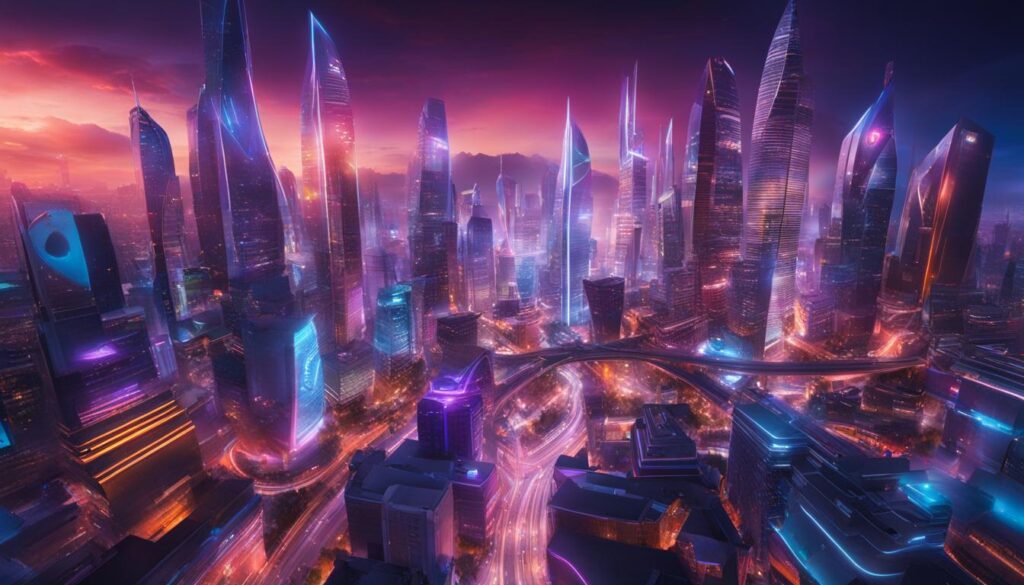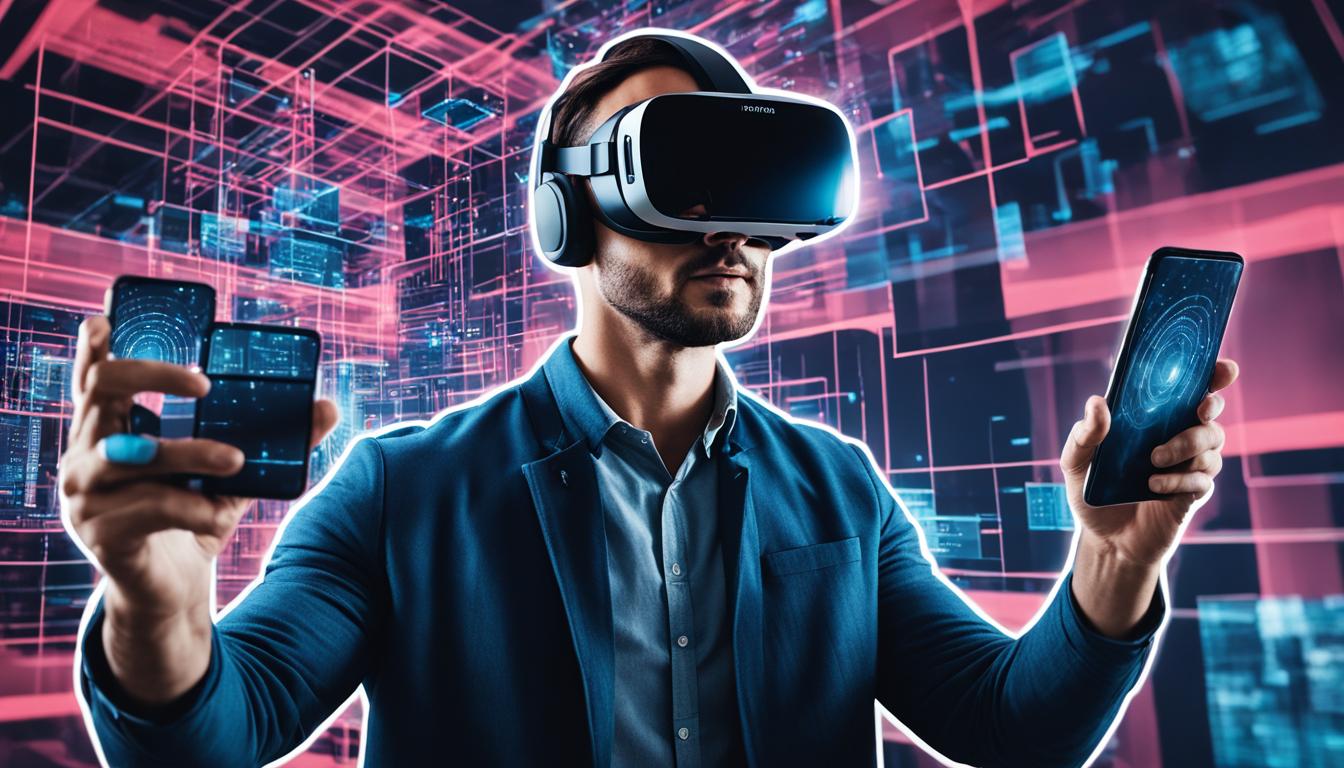Welcome to the world of virtual reality (VR) and augmented reality (AR). These cutting-edge technologies have revolutionized the way we interact with the digital world and the real world around us. But are VR and AR the same thing? Let’s dive in and discover the similarities and differences between these immersive technologies.
Virtual reality transports you to a completely computer-generated simulation of an alternate world. With the help of specialized equipment such as headsets and gloves, you can explore and interact within this virtual environment. On the other hand, augmented reality overlays virtual images and characters onto the real world using your smartphone’s camera or video viewer. It enhances your real-world experience by adding additional information and virtual elements to your surroundings.
Although VR and AR share the goal of enhancing our digital experiences, they differ in several key aspects. VR offers a fully immersive experience, completely replacing the real-world setting, while AR enhances our current reality by overlaying virtual objects onto it. VR requires dedicated headsets and equipment, whereas AR can be accessed through smartphones, making it more accessible to a wider audience.
So, while VR and AR share similarities in their ability to transport us to different realms, their approaches, devices, and applications set them apart.
Key Takeaways:
- Virtual reality (VR) and augmented reality (AR) are similar but distinct technologies.
- VR creates a computer-generated simulation, while AR overlays virtual images onto the real world.
- VR requires specialized equipment, such as headsets, while AR can be accessed through smartphones.
- VR offers complete immersion in a virtual world, while AR enhances our real-world experience.
- Both VR and AR have unique applications and are poised for significant growth in various industries.
What is Augmented Reality?
Augmented reality (AR) offers an exciting real-world experience by integrating virtual pictures and characters into your surroundings. Using your smartphone’s camera or video viewer, AR projects virtual elements onto the real world, enhancing your perception of reality. Unlike virtual reality (VR), which replaces the real-world environment entirely, AR allows you to interact with virtual and real-world elements simultaneously, creating a truly immersive and interactive experience.
With AR, you can see virtual characters, objects, and information overlayed onto your real-world environment, enhancing your understanding and engagement with your surroundings. By simply using your smartphone, you can unlock a world of additional information and interactive elements that enrich your everyday experiences.
“AR offers a unique way to blend the digital and physical worlds, providing users with a new perspective and a wealth of opportunities for exploration and interaction.” – [Insert Expert Name]
How Does Augmented Reality Work?
The process of experiencing AR starts with your smartphone’s camera or video viewer. As you point your smartphone at the real world, AR software recognizes and tracks the environment, identifying surfaces and objects. Utilizing this information, virtual pictures and characters are then superimposed onto specific locations in your real-world environment. This seamless integration of the digital and physical creates a captivating and interactive experience.
AR technology continues to evolve, and its applications are expanding in various industries such as gaming, education, marketing, and navigation. It is transforming the way we interact with our surroundings, providing additional layers of information and entertainment in our daily lives.
Benefits of Augmented Reality:
- Enhanced real-world experience and perception
- Interactive and engaging content overlay
- Increased accessibility through smartphones
- Combination of virtual and real elements
- Integration of additional information and interactive features
Augmented reality offers endless possibilities for enhancing our real-world experiences. Whether it’s exploring virtual landmarks, playing interactive games, or visualizing products in your home, AR provides an immersive and captivating way to interact with the world around you.
What is Virtual Reality?
Virtual reality (VR) is a groundbreaking technology that brings forth an immersive and captivating experience through a computer-generated simulation of an alternate world. By utilizing special equipment such as headsets, sensors, computers, and gloves, VR creates a virtual environment that users can explore and interact with.
Unlike augmented reality (AR) which overlays virtual elements onto the real world, VR completely replaces the user’s real-world setting, transporting them to a fictional reality. This level of immersion allows for a highly engaging and interactive experience, where users can feel as though they are truly existing in a virtual space.
Through the use of VR headsets and gloves, users can see and manipulate virtual objects, navigate through virtual environments, and even interact with other users in shared virtual spaces. This technology has found diverse applications in industries such as gaming, entertainment, training, education, and healthcare.
With VR, users can dive into a world of endless possibilities, whether it’s exploring fantastical realms, simulating realistic scenarios, or even reliving historical events. The level of detail and realism offered by VR creates a sense of presence and immersion that is unmatched by any other medium.

| VR and AR Job Opportunities | Required Skills |
|---|---|
| Software Engineer | – Strong programming skills (e.g., C++, Java, Python) – Knowledge of VR and AR development platforms (e.g., Unity, Unreal Engine) – Understanding of 3D graphics and interactive software development |
| Project Manager | – Excellent organizational and leadership skills – Ability to manage cross-functional teams – Knowledge of project management methodologies |
| Software Maintenance Professional | – Experience in software troubleshooting and debugging – Knowledge of software development life cycle – Proficiency in programming languages and frameworks |
| Graphic Designer | – Proficiency in graphic design software (e.g., Adobe Creative Suite) – Strong visual design and 3D modeling skills – Knowledge of UI/UX principles |
Conclusion
In conclusion, virtual reality (VR) and augmented reality (AR) are two distinct technologies with unique features and applications. While both offer immersive experiences, VR creates a completely computer-generated simulation, transporting users to alternate worlds. On the other hand, AR overlays virtual images onto the real world, enhancing the user’s real-life experience.
Despite their differences, VR and AR share similarities in terms of their ability to provide interactive and engaging experiences. Both technologies have the potential to revolutionize industries such as gaming, marketing, e-commerce, and education by delivering innovative and immersive solutions.
Looking towards the future, the VR and AR industry is poised for significant growth. As these technologies continue to advance, we can expect to see more job opportunities in fields such as software engineering, project management, software maintenance, and graphic design. The projected expansion of the VR and AR market indicates a promising future for individuals interested in pursuing careers in these fields.
The future of VR and AR holds great potential for transforming various aspects of our lives. With ongoing advancements, we can anticipate more realistic and interactive experiences, improved accessibility, and integration into different sectors. As VR and AR become more pervasive, their impact on industries and society as a whole is expected to expand in the coming years.
FAQ
Is Virtual Reality and Augmented Reality the same?
No, virtual reality (VR) and augmented reality (AR) are two distinct technologies. VR creates a computer-generated simulation of an alternate world, while AR overlays virtual images onto the real world.
What is Augmented Reality?
Augmented reality (AR) enhances the user’s real-life experience by projecting virtual pictures and characters onto the real world through a smartphone’s camera or video viewer. It adds virtual elements to the real-world environment, rather than replacing it.
What is Virtual Reality?
Virtual reality (VR) creates an immersive, computer-generated simulation of an alternate world. It uses special equipment like headsets, sensors, computers, and gloves to allow users to explore and interact with a virtual environment.
What are the differences between VR and AR?
VR takes place in an entirely virtual world, while AR overlays virtual images onto the real world. AR can be accessed through a smartphone, while VR requires specialized equipment like headsets. Additionally, AR enhances both the virtual and real world, while VR enhances a fictional reality.
What job opportunities are available in the VR and AR industry?
The VR and AR industry provides diverse job opportunities in software engineering, project management, software maintenance, and graphic design. As the market for VR and AR continues to grow, skilled professionals in these fields will be in high demand.




